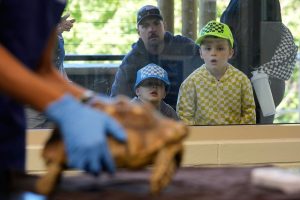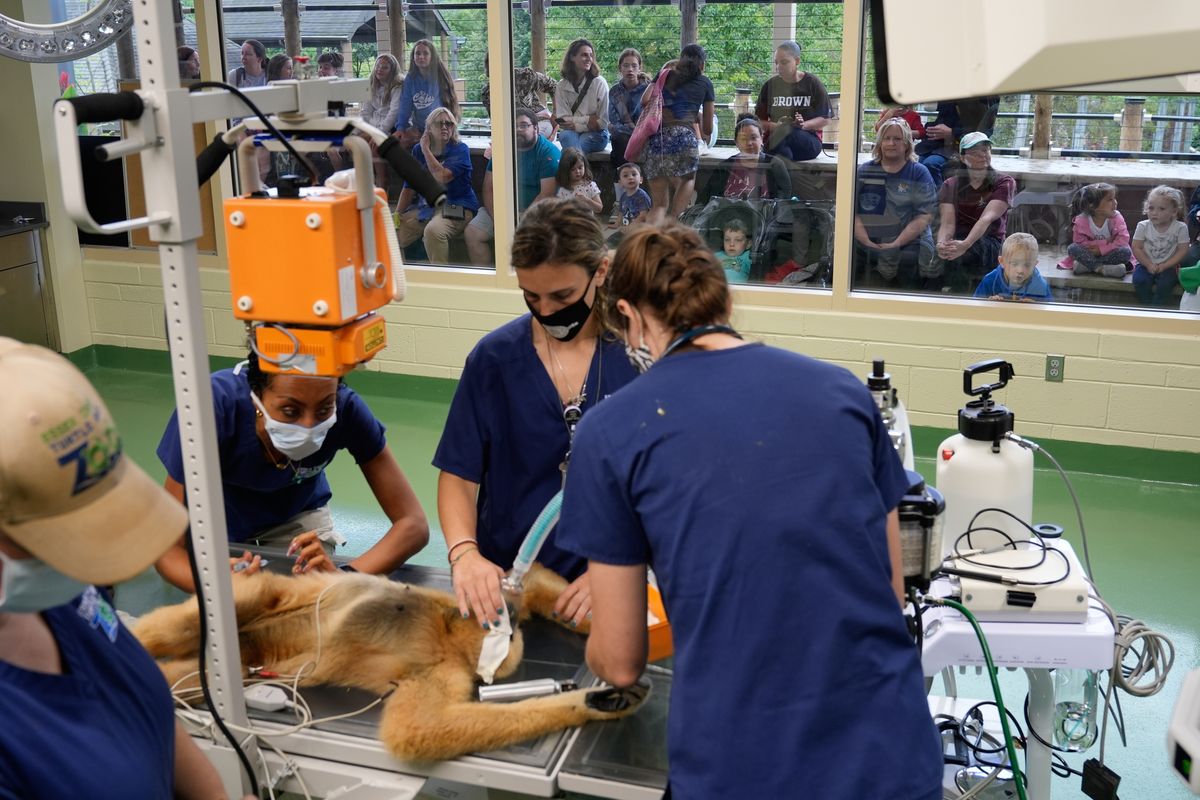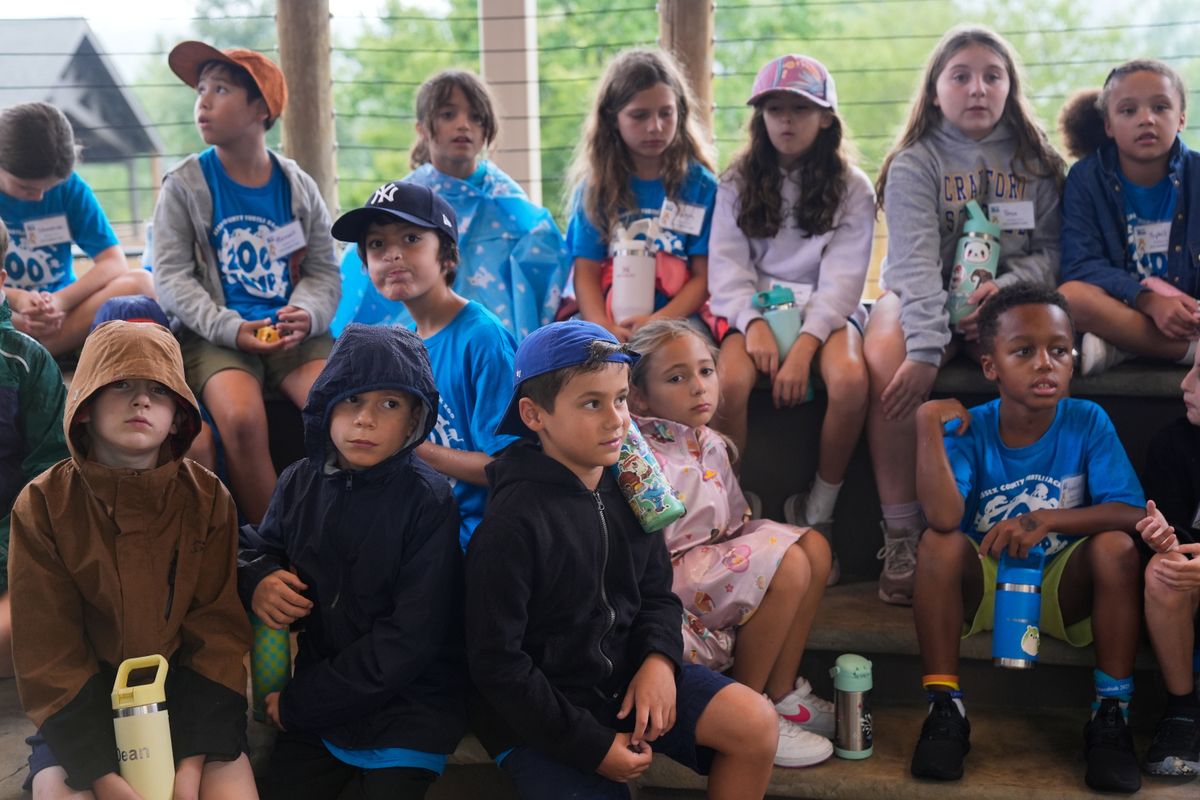WEST ORANGE, N.J. (AP) — Forget the giraffes, gibbons and leopards. About a dozen visitors at the Turtle Back Zoo gathered one recent morning around the most unusual sight of all.
It was a small, light-brown tortoise getting a veterinary checkup.
Over the next half-hour, spectators watched through a plate-glass window as the young sulcata tortoise — an endangered species also known as the African spurred tortoise — underwent measurements, X-rays, a blood draw, microchipping and more.
Inside the northern New Jersey zoo’s spacious new, publicly visible treatment room, Dr. Kailey Anderson tucked the gel-covered wand of a Doppler machine between the top and bottom of the tortoise’s shell to listen to its heart.
The nonplussed reptile pulled its head and thick-scaled front legs around the wand, trapping it in the wrong position. After Anderson coaxed the creature to relinquish the instrument, she got the chelonian equivalent of the cold shoulder when she tried to insert it again.
“You have to be really patient with tortoises,” Anderson explained. “Because if it’s ‘no, thank you,’ then it’s no.”
If the experience was new for the recently arrived tortoise, it also was a novelty for the onlookers.
Few zoos offer a window on veterinary care
The Turtle Back Zoo this year joined the relatively few U.S. zoos — perhaps a dozen or fewer among the 250 accredited by the Association of Zoos and Aquariums — that routinely give the public a view of veterinary care, said veterinarian and former accreditation commission member Dr. Scott Terrell.
“It’s a very easy way for the public to really understand and appreciate the care that these animals get,” said Terrell, who oversees animal care for Disney, where Animal Kingdom has let visitors observe veterinary care since 1998.
In an era when social media campaigns and lawsuits have questioned the well-being of captive animals, some zoos see putting vets on view as a form of transparency.
“Anytime things are out of sight, then people make up a narrative about what’s going on. I wanted to make sure, and the Nashville Zoo wanted to make sure, that people knew what was going on,” said that zoo’s animal health director, Dr. Heather Schwartz. A 200-seat observation deck and cameras were built into a 2019 veterinary center renovation.
At the Oklahoma City Zoo’s decade-old animal hospital, patrons have seen everything from routine exams to a gorilla’s hernia repair and a bison’s eye surgery, said Dr. Gretchen Cole, its veterinary services director. Visitors occasionally blanch, but Cole said she’d expected “more queasiness than we have.”
A suburban zoo’s turnaround
The compact, suburban Turtle Back Zoo hosts about 150 species and is recognized for its contributions to clouded leopard conservation and sea turtle rehabilitation. More whimsically, it’s known for a friendship between a cheetah and Labrador retriever that had a social media moment.
Opened in 1963, the county-owned zoo was threatened with closure amid financial problems and poor attendance in the mid-1990s. A steady march of renovations and additions in the 2000s turned things around, and it now draws nearly 1 million visitors per year and is financially healthy, said longtime Essex County Executive Joseph DiVincenzo Jr., who has presided over the rebirth.
With more animals, the zoo needed a bigger, updated veterinary hospital. Financed with state, federal and county money, the new $17 million building opened in April and lets visitors see into the room where animals get exams and some other procedures (surgeries happen off-view in a separate area).
It was a way to provide a new attraction, and “I want the kids to be able to learn what’s going on, not just to see the animals,” said DiVincenzo, a Democrat. Zoo director Jilian Fazio hopes that watching vet care also will help visitors relate to animals and get involved in conservation.
On a sunny Saturday in September, signs and announcements invited visitors to see the sulcata tortoise’s exam. The animal was brought to the zoo after being found on a New Jersey street, Fazio said. The reptile’s origins are unclear; sulcatas sometimes are kept as pets, though the state requires a permit for that.
How to examine a tortoise? Slow and steady
Adults generally reach at least 75 pounds (34 kilograms) over time. But for now, the tortoise was compact enough for vet tech Madison Miranda to hold it up as Anderson, the veterinarian, delicately endeavored to grasp one of its legs for a blood draw.
She tried a front leg, which the reptile pulled in and huddled. Then a back leg. Then the front again. Then an area under the shell near the head. An attempt came close.
“Oh, you are so good,” Anderson soothingly told the tortoise as she prepared to try again. “A little poke. Little poke. … There we go.”
“We found the sweet spot!” the veterinarian said as she withdrew the syringe and used a tongue depressor to hold a swab to the injection site.
She would eventually need more blood and a mouth swab for additional tests, plus another go at hearing the heartbeat. But since the tortoise was quarantined as a new arrival, those procedures could wait. Anderson had seen enough to conclude that the as-yet-unnamed animal seemed healthy and was likely a female.
After an antimicrobial bath, the patient was headed back to her enclosure for a treat: strawberries.
But first, Miranda carried her to the viewing window, where 10-year-old Eleanor Wei and her mom, Shuqing Wu, lingered on the other side.
“I think it’s really cool how they just do the veterinary care,” Eleanor said. She added that she was “glad to have a real-life experience.”
By JENNIFER PELTZ
Associated Press





